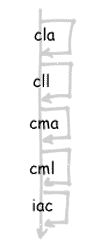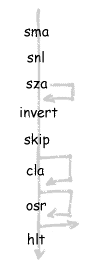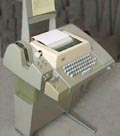
PDP-8 Simulator
Ward CunninghamCunningham & Cunningham, Inc.
The Digital Equipment Corporation's PDP-8 minicomputer offered tabletop computing at a time when human hands still wove cores. By 1975 retired instances of DEC's most popular eight, the PDP-8e, were showing up on the surplus market. My friend Jim Wilson had one for which I wrote amateur radio software.
I wrote this PDP-8 simulator at the same time. One could assemble a program with no more than a basic 8 and a teletype. But the arduous process involving feeding multiple paper tapes multiple times through the teletype's ten character per second reader. I opted for the remote batch environment offered by the university's CDC-6000 series mainframe. I used this simulator to run the stock PAL-8 assembler from a timesharing terminal.
I was concerned with execution speed since I expected to run assemblies
often and would be waiting for them to finish. But I was even more concerned
with development speed. Time spent on the simulator wasn't going into my
radio programs. I implemented only those features used by PAL-8. I wrote
in a mixture of FORTRAN and 6000 assembler using a conservative style.
I had only one error. I had the sense of test wrong for the SZA instruction.
I tracked it down by running DEC's hardware diagnostics. (See note below.)
Instructions
ir = mem[pc]
pc = pc+1
case ir
...
OPERATION MEMORY
_CODES 0-5_ PAGE
/___ ___ ___\___/___\___ ___ ___ ___ ___ ___ ___
| | | | | | | | | | | | |
| 0 | 1 | 2 | 3 | 4 | 5 | 6 | 7 | 8 | 9 | 10| 11|
|___|___|___|___|___|___|___|___|___|___|___|___|
\ / \_________ _________/
INDIRECT ADDRESS
ADDRESSING
Memory Reference Instruction Bit Assignments
Address decoding begins with the lower seven instruction bits forming an offset within a memory page. These are either merged with bits from the program counter or zeros to address a word in the current page or first page respectively. This addressed word is then used directly as the operand or indirectly as the address of the operand. As a final twist, a few words of every page will automatically increment with each indirect reference through them.
Note: Ben Fairbank (personal correspondence, 2001) has pointed
out that autoindexing only worked
on page zero. Here is the description from
Introduction to Programming, Digital Equipment Corporation, 1973.
Apparently neither the machine diagnostics or the PAL assembler depended
on this distinction.

| INT1 (bookkeeping)
INT1.1 FETCH X5,X7
GET INSTRUCTION
INT5 (Jump table) |
| AND
logical and TAD
ISZ
DCA
JMS
JMP
OPR
IOT
|
| AND FETCH
X3,X4
BX2 X2*X4 EQ INT1 TAD FETCH X3,X4 MX6 -13 IX2 X2+X4 BX2 -X6*X2 EQ INT1 ISZ FETCH X3,X4 SX4 X4+B1 BX4 X0*X4 STORE ,X4 NZ X4,INT1 SX5 X5+B1 BX5 X0*X5 EQ INT1 DCA BX4 X0*X2 STORE X3,X4 BX2 -X0*X2 EQ INT1 JMS STORE X3,X5 SX5 X3+B1 BX5 X0*X5 EQ INT1 JMP BX5 X3 EQ INT1 IOT LX7
8-59
|
ROTATE 1
ROTATE IF A 0,
OPERATION
AC AND L 2
__ CODE 7 _
CLA CMA RIGHT IF
A 1
/___ ___ ___\___/___\___/___\___/___\___/___\___
| | |
| | | | | |
| | | |
| 0 | 1 | 2 | 3 | 4 | 5 | 6 | 7 | 8 | 9 |
10| 11|
|___|___|___|___|___|___|___|___|___|___|___|___|
\ / \ / \ /
\ / \ /
CONTAINS CLL CML
ROTATE IAC
A 0 TO
AC AND L
SPECIFY
LEFT
GROUP 1
Group 1 Operate Instruction
Bit Assignments

| OPR (Group
decoding)
GP1 LX7 8-7 PL X7,GP1.1 BX2 -X0*X2 CLA GP1.1 LX7 7-6 PL X7,GP1.2 BX2 X0*X2 CLL GP1.2 LX7 6-5 PL X7,GP1.3 BX2 X0-X2 CMA GP1.3 LX7 5-4 PL X7,GP1.4 BX2 -X0-X2 CML MX6 -13 BX2 -X6*X2 GP1.4 LX7 4-0 PL X7,GP1.5 SX2 X2+B1 IAC MX6 -13 BX2 -X6*X2 GP1.5 MX6 -3 BX6 -X6*X7 SB6 X6 JP GP1.6+B6 GP1.6 (Jump
table)
|
| BSW BX6
-X0*X2
BX1 X0*X2 LX1 6 BX2 X0*X1 AX1 12 BX2 X2+X1 BX2 X2+X6 EQ INT1 RAL MX1 -13 (Duplicated for RTL,RAR,RTR) LX2 1 BX6 X1*X2 BX2 -X1*X2 AX6 13 BX2 X2+X6 EQ INT1 |
REVERSE
SKIP
OPERATION
SENSING OF
__ CODE 7 _
CLA SZA BITS 5,6,7 HLT
/___ ___ ___\___/___\___/___\___/___\___/___\___
| | |
| | | | | |
| | | |
| 0 | 1 | 2 | 3 | 4 | 5 | 6 | 7 | 8 | 9 |
10| 11|
|___|___|___|___|___|___|___|___|___|___|___|___|
\ / \ / \ /
\ / \ /
CONTAINS SMA SNL
OSR CONTAINS
A 1 TO
A 0 TO
SPECIFY
SPECIFY
GROUP 2
GROUP 2
Group 2 Operate Instruction
Bit Assignments

| GP2 LX7
0-6 SMA
BX6 X2 LX6 59-11 BX1 X7*X6 LX7 6-4 SNL LX6 11-12 BX6 X6*X7 BX1 X1+X6 LX7 4-5 SZA BX6 X0*X2 NZ X6,GP2.1 BX1 X1+X7 GP2.1 LX7 5-3 SENSE OF TEST BX1 X7-X1 LX1 1 MX6 -1 BX1 -X6*X1 IX5 X5+X1 INCR PC IF TRUE BX5 X0*X5 LX7 3-7 CLA PL X7,GP2.2 BX2 -X0*X2 GP2.2 LX7 7-2 OSR PL X7,GP2.3 SA1 SR BX2 X2+X1 GP2.3 LX7 2-1 HLT PL X7,INT1 EQ INT0 |
AN IOP 4 AN IOP 1
PULSE AT PULSE AT
OPERATION TIME 3 TIME 1
IF A 1 IF A 1
_ CODE 6 _
/___ ___ ___\___ ___ ___ ___ ___ ___/___\___/___\
| | | | | | | | | | | | |
| 0 | 1 | 2 | 3 | 4 | 5 | 6 | 7 | 8 | 9 | 10| 11|
|___|___|___|___|___|___|___|___|___|___|___|___|
\________ _______/ \ /
DEVICE GENERATES
SELECTION AN IOP 2
PULSE AT
EVENT TIME 2
IF A 1
IOT Instruction Bit Assignments
Compound Dispatch
Block Buffering
| SUBROUTINE PDP8IOT
(entry
and dispatch)
* PAPER TAPE READER
246 PRINT 245,(LTB(I1),I1=1,NTP)
404 (errors) |
Operations
The simulator reads commands from a file. Most commands correspond to front-panel switches or buttons. A few more control the loading or punching of tape at the teletype. The remainder measure and report progress within the simulation job.
ASR-33 Teletype
| * COMMAND PROCESSING LOOP
202 (Read and dispatch) * AC - ACCUMULATOR 310 I2=AC 312 PRINT 314,I1,I2 314 FORMAT(XA2': 'O4) GOTO 202 * LO - LOAD ADDRESS 320 PC=MA=SR GOTO 202 * CL - CLEAR 330 AC=LK=0 GOTO202 * CO - CONTINUE 340 STEP=ISC CALL INTRPT CALL FLSHTP GOTO 202 * DE - DEPOSIT 350 MD=SR CALL STORE 351 MA=PC=(MA+1).AND.7777B GOTO 202 * EX - EXAMINE 360 CALL FETCH PRINT 362,MA,MD 362 FORMAT(' EX: 'O4XO4) GOTO 351 * HA - HALT 370 CALL RI(ISC) IF(ISC.EQ.0) ISC=-1 ISC=MIN0(ISC,777777B) GOTO 202 * MA - MEMORY ADDRESS 380 I2=MA GOTO 312 * MD - MEMORY DATA 390 I2=MD GOTO 312 * ST - STATUS 400 I2=4000B*LK GOTO 312 * SW - SWITCH REGISTER 410 CALL RO(SR) SR=SR.AND.7777B GOTO 202 * PC - PROGRAM COUNTER 420 I2=PC GOTO 312 * PR - PAPER TAPE READER 430 I1=1 CALL FLSHPR 432 CALL RC(I2) CALL NEWNAME(I1,REPLTR(I2,1H ,0)) REWIND I1 GOTO 202 * PP - PAPER TAPE PUNCH 440 I1=2 CALL FLSHPP ENDFILE I1 GOTO 432 * TI - CPU TIME 450 CALL SECOND(T1) PRINT 452,T1 452 FORMAT(' TI:'F8.3) GOTO 202 * RI - ENTER RIM LOADER 460 DO 462 I1=1,16 MA=7755B+I1 $ MD=RIM(I1) 462 CALL STORE GOTO 202 * PU - LOW SPEED PUNCH 470 CALL RI(LSP) IF(LSP.EQ.0) CALL FLSHPP GOTO 202 * ME - CONSOLE MESSAGE 480 CALL RS(MSG,5) CALL MESSAGE(MSG) GOTO 202 |
Perspective
This program has been formatted to be read by a wider audience than originally intended. The original source was organized as a single file containing both FORTRAN and 6000 assembler. It contained SPACE and EJECT directives that exerted some control over the listing. The assembler listing would show how well the 15- to 30-bit instructions fit into the available 60-bits of each CDC word. A careful programmer also watches for functional unit conflicts and in-stack loops.The coding conventions were adapted from Greg Mansfield, author of the MACE operating system and many of the tools and utilities that ran on it.
Some related files have been lost, notably the PAL-8 assembler binary
and the hardware diagnostics tape. I wrote one command script with six
or eight cards and never wrote another. This is missing too.
Bibliography
Preserving Computing’s Past: Restoration and Simulation,Maxwell M. Burnet and Robert M. Supnik, 1996
http://www.digital.com/DTJN02/DTJN02HM.HTM
A PDP-8/E Simulator for the Apple Macintosh,
Bernhard Baehr, 1998
http://www.han.de/~bb/pdp8e/pdp8e.html
Project: PDP-8 Computer,
Barry J. Stern, [Java Applet; runs Focal]
http://www.in.net/~bstern/PDP8/pdp8.html
JavaScript PDP-8 Simulator,
Neal Sample, University of Wyoming
http://strawberry.uwyo.edu/~nsample/pdp8/main.htm
JavaScript PDP-8 Assembler,
Mark G. Arnold, University of Wyoming
http://www.cs.uwyo.edu/~marnold/asm8.html
DEC's 1967 PDP-8 Pocket Reference Card,
A Programmer's Reference Manual for the PDP-8,
Douglas W. Jones, University of Iowa
http://www.cs.uiowa.edu/~jones/pdp8/refcard/67.html
http://www.cs.uiowa.edu/~jones/pdp8/man/
A Seymour Cray Perspective
Gordon Bell, 1997
http://research.microsoft.com/~gbell/craytalk/sld001.htm
Image Index
Australian Computer Museum Society Inc
http://www.terrigal.net.au/~acms/z00.htm
Morse Code Receiver/Transmitter
Ward Cunningham
http://c2.com/~ward/morse/pdp8/
An Experiment in the Restoration and Preservation of Programs
Ward Cunningham, 1998
(in preparation)